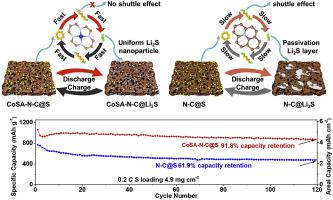Energy Storage Materials ( IF 20.4 ) Pub Date : 2020-05-29 , DOI: 10.1016/j.ensm.2020.05.022 Yuanjian Li , Jiabin Wu , Bao Zhang , Wenyu Wang , Guoqun Zhang , Zhi Wei Seh , Nian Zhang , Jie Sun , Liang Huang , Jianjun Jiang , Jun Zhou , Yongming Sun

|
Lithium-sulfur (Li–S) batteries are appealing energy storage technologies owing to their exceptional energy density. Their practical applications, however, are largely compromised by poor cycling stability and rate capability because of detrimental shuttling of polysulfide intermediates, complicated multiphase sulfur redox reactions, and uncontrolled precipitation of the discharge products (lithium sulfide, Li2S). Herein, monodispersed Co single-atom catalyst on conductive nitrogen-doped carbon nanosheet (CoSA-N-C) with high Co content of 15.3 wt% was fabricated through a salt-template method and used as a sulfur host material to simultaneously alleviate the polysulfide shuttling, propel the redox kinetics of dissolved polysulfides, and mediate the deposition of Li2S. The robust two-dimensional architecture of CoSA-N-C with large surface area, high porosity, and dual lithiophilic-sulfiphilic Co–N species enable strong physical and chemical polysulfides confinement and fast electrons/ions transfer process. The densely populated Co–N4 coordinated moieties function as electrocatalytic sites to accelerate the reversible conversion between lithium polysulfides and Li2S. Importantly, the CoSA-N-C enables spatially controlled deposition of Li2S nanoparticles during the battery discharge process, as opposed to conventional Li2S passivation layers that fully covered the conductive host. Consequently, the as-fabricated cathodes based on the CoSA-N-C deliver high sulfur utilization (1574 mAh·g−1 at 0.05 C), outstanding rate capability (624 mAh g−1 at 5 C) and superior long-term stability (capacity fade rate of 0.035% per cycle for 1000 cycles at 1 C). Even under a sulfur loading up to 4.9 mg cm−2, the reversible areal capacity could reach 4.24 mAh cm−2 after 120 cycles at 0.2 C, delivering an ultrahigh capacity retention of 91.8%. This work sheds inspiring insights on the important role of single atomic metal with high mass loading in mediating the deposition of lithium sulfides and accelerating the reversible conversion of lithium polysulfides toward decent-performance Li–S batteries.
中文翻译:

使用高负载钴单原子在锂硫电池中快速转换和控制沉积(多)硫化锂
锂硫(Li–S)电池由于其卓越的能量密度而吸引了能量存储技术。但是,由于多硫化物中间体的不利穿梭,复杂的多相硫氧化还原反应以及放电产物(硫化锂,Li 2 S)的失控沉淀,循环稳定性和速率能力差,极大地损害了它们的实际应用。在此,通过盐模板法在Co含量为15.3 wt%的导电氮掺杂碳纳米片(CoSA-NC)上制备了单分散Co单原子催化剂,并用作硫基质材料以同时减轻多硫化物的穿梭,促进溶解的多硫化物的氧化还原动力学,并介导Li 2的沉积S.坚固的二维CoSA-NC二维结构,具有大的表面积,高孔隙率和双亲硫-亲硫Co-N物种,可实现强大的物理和化学多硫化物限制,并实现快速的电子/离子转移过程。人口稠密的Co-N 4配位基团起电催化作用,以加速多硫化锂和Li 2 S之间的可逆转化。重要的是,与电池放电过程相比,CoSA-NC可以在空间上控制Li 2 S纳米粒子的沉积传统的Li 2 S钝化层完全覆盖了导电主体。因此,基于CoSA-NC的预制阴极可提供高硫利用率(1574 mAh·g-1 0.05 Ç),突出的速率能力(624毫安克-1在5 Ç)和优异的长期稳定性(在1个的每个周期0.035%为1000次循环的容量衰减率Ç)。即使在硫负载高达4.9毫克厘米-2,可逆面积容量可达到4.24毫安厘米-2 0.2 120次循环后Ç,提供的91.8%的超高容量保持率。这项工作使人们对具有高质量负载的单原子金属在介导硫化锂的沉积和加速多硫化锂向性能良好的Li-S电池的可逆转化方面的重要作用具有启发性的见解。


























 京公网安备 11010802027423号
京公网安备 11010802027423号